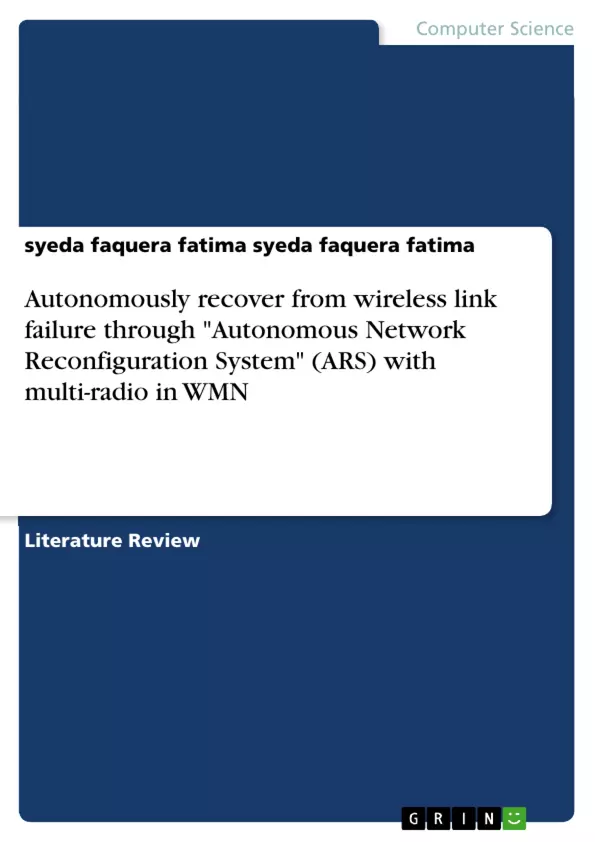This paper describes the technique to recover from the failures that occurs in Wireless Mesh networks(WMN) like node failure, link failures etc, due to channel interference, dynamic obstacles or application bandwidth demands. This paper presents an Autonomous network Reconfiguration System (ARS) that enables a multi-radio WMN to autonomously recover from local link failures to preserve network performance.
ARS has been implemented and evaluated extensively on our IEEE 802.11-based WMN test-bed as well as through ns-2-based simulation. By using channel and radio diversities in WMNs, ARS generates necessary changes in local radio and channel assignments in order to recover from failures. Next ARS’s on-line reconfigurability allows for real-time failure detection and network reconfiguration, thus improving channel-efficiency by 92%. Our evaluation results demonstrated the effectiveness of ARS in recovering from local link-failures and in satisfying application’s diverse QoS demands.
Inhaltsverzeichnis (Table of Contents)
- 1.INTRODUCTION:
- 2. EXISTING SYSTEM:
- 2.1 Localized reconfiguration:.
- 2.2 QoS-Constraints:..
- 2.3 Cross-layer interaction:
- 2.4 Limitations of Existing System: ........
- 3.proposed system:.
- 3.1 The ARS Architecture:.
- 3.2 Multi-radio WMN (mr-WMNS):..
- 3.3 Localized Network Reconfiguration: .
- 3.3.1 Generating feasible plans:...........
- 3.3.2 QoS-Satisfiability Evaluation:
- 3.3.3 Choosing the best plan:.
- 3.4 Complexity of ARS:
- 3.5 Advantages of proposed system:.
- 4. PERFORMANCE EVALUATION:..
- 4.1 Methodology.
- 4.1.1 Simulation Environment:.
- 4.2Module Descriptions:.
- 5. Results And Analysis:..
- 6.CONCLUSION: .
- 7.FUTURE WORK:
- 8.REFERENCES:
Zielsetzung und Themenschwerpunkte (Objectives and Key Themes)
This paper explores the challenges of maintaining performance in Wireless Mesh Networks (WMNs) amidst dynamic wireless link conditions. It introduces an Autonomous Network Reconfiguration System (ARS) that enables multi-radio WMNs to recover autonomously from local link failures. The ARS aims to preserve network performance by efficiently reconfiguring local radio and channel assignments in real-time.
- Autonomous Network Reconfiguration System (ARS)
- Local Link Failures in Wireless Mesh Networks (WMNs)
- Channel and Radio Diversity
- Real-time Failure Detection and Recovery
- QoS-aware Network Reconfiguration
Zusammenfassung der Kapitel (Chapter Summaries)
- 1. INTRODUCTION: This chapter introduces the challenges of maintaining performance in WMNs due to factors like channel interference, dynamic obstacles, and bandwidth demands. It highlights the limitations of existing solutions and introduces the concept of ARS as a potential solution.
- 2. EXISTING SYSTEM: This chapter explores existing approaches for handling link failures in WMNs, including resource-allocation algorithms, greedy channel-assignment algorithms, and fault-tolerant routing protocols. It identifies the limitations of these approaches, emphasizing the need for localized and dynamic solutions.
- 3. PROPOSED SYSTEM: This chapter details the proposed ARS architecture, including its multi-radio WMN (mr-WMN) framework and the localized network reconfiguration process. It explains how ARS generates feasible reconfiguration plans, evaluates their QoS-satisfiability, and chooses the best plan based on minimal changes. It also discusses the advantages of the proposed system.
- 4. PERFORMANCE EVALUATION: This chapter describes the methodology for evaluating the ARS, including the simulation environment and module descriptions. It provides insights into the performance evaluation process.
Schlüsselwörter (Keywords)
The core keywords and focus topics of this paper encompass: Wireless Mesh Networks, Autonomous Network Reconfiguration System, Channel and Radio Diversity, Online Reconfigurability, QoS-aware Reconfiguration, Local Link Failures, Performance Evaluation, Simulation Environment, and Network Performance.
- Arbeit zitieren
- syeda faquera fatima syeda faquera fatima (Autor:in), 2018, Autonomously recover from wireless link failure through "Autonomous Network Reconfiguration System" (ARS) with multi-radio in WMN, München, GRIN Verlag, https://www.grin.com/document/418538



